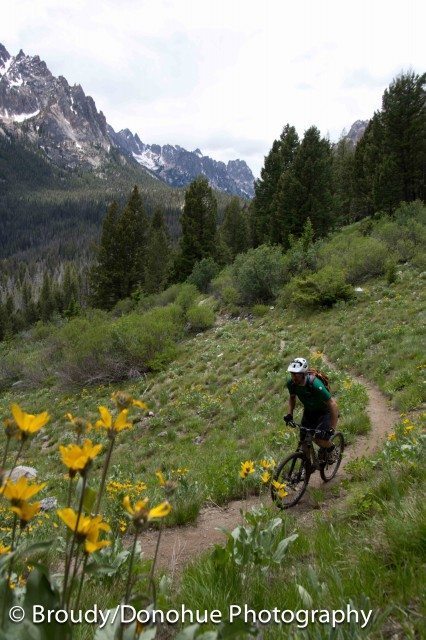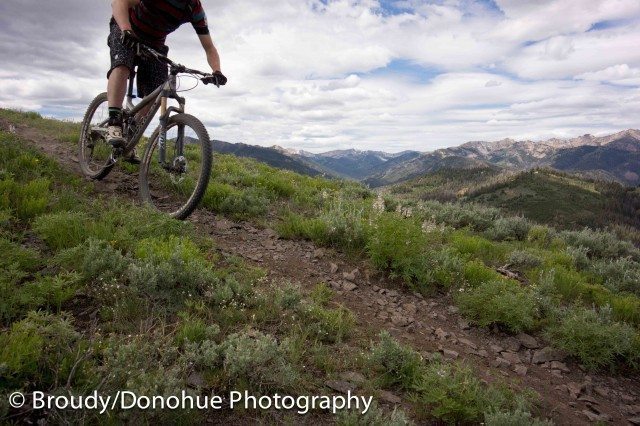Climbing
I hate it when bike reviewers use silly similes to describe how a bike climbed: like a meth-addicted mountain goat, like a jackrabbit on Mexican 8-ball, like an early Soviet rocket beating the Americans to space. Since I’m not clever and the Turner is not a bike that inspired any particular simile, I’ll just try to provide some information that’s actually useful, because honestly, the last thing you want to be riding on is a meth-addicted mountain goat.
The Burner is a bike that climbs well, but you’re never going to confuse it with a carbon-framed wonder bike with carbon wheels and super-light tires. I’ve ridden a couple of those (Scott Genius 700 carbon, Ibis Mojo HD carbon frame with Easton carbon wheels), and they climb like a penguin that’s been shot out of a cannon.
I definitely had the chance to put the Burner through its paces on many long fire-road and singletrack climbs in the Sun Valley area, many of which were surprisingly rough, considering SV’s reputation as a buff-trail paradise.
At sub-30 pounds as built, the Burner can hang weight-wise with many bikes on the market. The 17.6” chainstays are relatively short for a dw-link bike, but not to the point that you feel like the front end is going to break with the ground if you put your chest down near the stem and pull the bars through your hips.
The 3.75” head tube on my size medium, coupled with a zero-stack Cane Creek 40 headset and minimal spacers under the stem meant that my body position was pretty low on the bike.
Geometry-wise, the Burner is a decent climber – relatively low BB, relatively low overall weight, short stem stack, chainstays that will keep the front wheel on the ground, 140mm of fork travel. Having spent a lot of time on my Trek Fuel EX, and a little bit of time on an Ibis Mojo HD carbon, and a Scott Genius 700 carbon in the recent past, I would say that the Burner climbs better than the Trek due to its superior suspension performance but not quite as efficiently as the Ibis or Scott due in large part to the weight difference between these bikes. Note that the Mojo HD shares the dw-link with the Burner.

The Burner certainly doesn’t have XC race bike geometry where you body is low and centered at all times, but that’s not the point of this bike. The frame is set up to climb well enough to get you up something that’s fun to come down. And isn’t that the whole point?
The Burner comes equipped with a Fox CTD Evolution shock on the dw-link and a Fox 34 Float FIT CTD up front. For those unfamiliar with CTD, it’s basically three settings standing for Climb-Trail-Descend and you’re supposed to use each setting for different trail segments. If you use them where they perform best, you’ll get a lot of bang for your buck out of the DW-link platform and fork.
On the Burner, Climb should be re-labeled ‘boring sections of fire road or pavement,’ since this setting causes the bike to act like hard-tail. If you’re into that, you might love the Climb setting on singletrack climbs. Personally, I barely used it as I found that it would cause the bike to lose traction.
The shop mechanics at Pete Lane’s in Sun Valley told me that Turner actually recommends that you generally use the Trail setting for climbing and general riding. I found this recommendation to be spot on. The Trail setting did the job nicely with virtually no pedal bob while seated, and only minimal pedal bob during out-of-the-saddle efforts.
The exception to this efficient climbing was when the bike was in Descend mode on climbs or rolling trail. If I was seated and pedaling smoothly, suspension bob wasn’t too bad. But as soon as I stomped on the pedals a bit, or got out of the saddle for shorter, steep sections, the bike would bounce all over the place. I would attribute this less to poor design than I would to poor use of the design. Descend mode is for just that—I don’t think it’s worth using on rolling trail or climbs at all. Trail mode performed exactly as I wanted it to in smooth or rough sections of trail that were either uphill or contouring.
On my Fuel EX, I have a Fox RP23 DRCV shock specially tuned for the Trek Fuel line featuring ProPedal. I generally leave the bike in the Open position as ProPedal is generally too stiff for anything but dirt roads. It’s efficient on climbs and rolling trail, but not nearly as efficient as the Burner. There is less pedal bob with the Burner and just as much supple travel when needed. Power transfer to the rear wheel is incredible with the dw-link equipped with the Fox CTD Evolution.
To sum it up, the Burner’s frame geometry that is pretty good for climbing, but it has a suspension system that is great for climbing. When combined, the suspension characteristics more than make up for the fact that the geometry isn’t the fastest uphill (but will get you downhill with far more control than a frame that is designed to go fast on the climb).
Descending
If the Turner isn’t an absolute standout on climbs, it is incredible on descents.
First, the suspension. With a Fox 34 Float FIT 15QR fork up front, coupled with a stout Stan’s Arch EX wheel, the front feels plenty stiff in rocky, off-camber descents. When I toggled the fork to Descend mode, the fork felt bottomless, and not once did I experience harsh ramping at the end of the fork’s travel.
Over the course of seven days of riding, I rode a lot of different trails with the Burner. Sun Valley does have a lot of epic, buff, remote single track that requires a ton of pedaling, but it also has a few stout, steep, semi-technical shuttle-style trails to shred, so the Burner got a workout there as well. I would have liked to take it on some bigger Moab-style drops (three to four feet is about where I feel OK on a trail bike) to see what kind of response I could get from the bike, but there weren’t many to be found, at least on the rides I did.
The rear suspension was amazing as well—supple, responsive, and tight through chattery sections. In Trail mode, you get full travel with a slightly stiffer feel. When opened up into Descend mode you get a plush ride that will gobble up fast small hits or large square-edgers with ease.
Frame-wise, the Burner is plenty stiff. Never once did I feel as if the bike was flexing unexpectedly. Turner makes frames that are stout (and generally a bit heavy) and the Burner is no exception.


soooo- i have been lusting after a burner. and i am a sv loc
does pete lanes have demos?
thanks for the great write up. i am thinking ccdb air, lowered lyrik dh up from. 2×10 shimano drivetrain, saint breaks, and dropper . 30 ish lb trail killa
mb –
Pete Lane’s does have Turner Burner demos. When we were there (mid-June) they hadn’t yet received their size large frame but were waiting for it. So they should have the full run from S to L now. They’re set up pretty sweet, but you’ll be bummed there’s no dropper (hard thing to put on a demo/rental). Go talk to Greg (shop manager) – mention that you saw this review, he helped me out.
Have fun out in SV – missing those trails already. I still have daydreams about Oregon Gulch.
Dana – this is absolutely the most useful and informative bike test I’ve ever read. Ever. Dave T should have you do tests on ALL of his bikes! Hell – EVERYBODY should have you do their reviews!! And Blister owes you a raise. Kudos, in a big way. I’d been shopping for awhile. Was all about a 5.Spot. Saw the Burner on the website – and until I saw your review, couldn’t find flying monkey poop strings about it. Nothing that was particularly useful, anyway. I went ahead with the 5.Spot. Even after reading Bazar’s test of the 2011 edition (kidding – it was also very helpful). It’ll work better for me and where we ride. Chomping at the bits to get it in some mud. The decision sure didn’t reflect on your Burner review, though. You kick the proverbial butt with this stuff. Well done! And no disrespect to Bazar’s 5.Spot review. He did a helluva job with it. Better in every way than any of the glossy-page MTB magazine-rack tomes can do. But you just busted this one up in a big way. Ho yea.
Thanks, Jimicarl. I had a lot of fun riding that thing, and I think it’s definitely a bike worth considering for anyone considering making the 27.5 jump – which I think is a jump many people might just want to consider.
I have about 3 months logged on my Burner and this review is very accurate. Everything I would say to describe the Burner is summed up with this review. Nice job.